Closing the freedom-of-choice loophole in a Bell test
- Post by: admin
- November 3, 2010
- 2 Comments
Our paper “Violation of local realism with freedom of choice” has just been published in the Proceedings of the National Academy of Sciences (PNAS).
An explanatory post on a paper about Bell inequalities usually starts with recounting the history and controversy of entanglement starting in 1935. I’ll spare you this part, you’ve probably read it countless times before. So let’s cut to the chase. We experimentally closed the so-called (as of now) freedom-of-choice loophole.
Freedom of choice is related to, but not quite the same, as its better known cousin the locality loophole. The locality loophole arises when the measurement results on one system can be influenced by a measurement or by the setting choice event (the choice of which measurement will be performed) on a second, spatially separated system and vice versa. This causal influence is defined within the framework of special relativity – an event can influence another by signals travelling at, or below the speed of light. Experimentally, this can be guaranteed by locating these events outside each others future light-cone, i.e. further apart than a signal at light speed can travel within the timing difference of the involved events.
Freedom of choice means that the setting choices must themselves be free of any potential influence by the event which created the two systems in the first place. In other words, similar to above, the choice of measurement settings, in practice generated by a quantum random number generator (which is another crucial requirement), has to occur outside of the future light cone of the event that created the two (entangled) systems and hence imprinted the hidden variable on them.
The freedom-of-choice loophole is a crucial requirement for the derivation of Bell’s inequality. Interestingly though, it had until now not been addressed experimentally, and even been somewhat overlooked in recent literature on this topic.
The experiment itself was carried out between the islands of La Palma and Tenerife, a great place for holidays, astronomy and free-space experiments (in that order). We created entangled photons in a source at La Palma. One photon of each pair was kept at La Palma, the other one sent to Tenerife, where it was received by the European Space Agency’s Optical Ground Station telescope (see photo below). To close the locality and freedom-of-choice loopholes, the source, the quantum random number generators, and the measurements were distributed over 3 carefully selected locations. The measurement settings were applied via fast electro-optical switches. Eventually, we measured an experimental Bell value of ~2.37, well above the local realistic bound of 2.
Interesting side fact: the entangled photon source was operated at a maximum output of 2 million detectable pairs, which is AFAIK a record for a mobile, diode-pumped setup.
An equally interesting part of this paper is that we make an attempt to find a simple classification for the multitude of existing hidden variable models. For more details, read the paper.

Entanglement loophole closed
A long-distance experiment rejects a challenge to quantum physics.
http://www.sciencenews.org/view/generic/id/64935/title/Entanglement_loophole_closed
An old USSR joke:
Question: Is it true that the USSR-made car “Volga” makes a 90-degree turn at 100 km/hr?
Answer: Yes…. but only once.
– Is entanglement a “yes, but only once” affair for each entangled objects pair/group?
and, if so indeed,
– Are the states-of-systems of entangled objects decided upon separation of the objects, not upon their measurment?
Dov Henis
(Comments From The 22nd Century)
DNAnomics Is Not Genomics
http://www.the-scientist.com/news/display/57814/